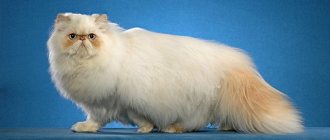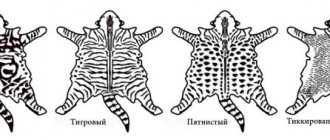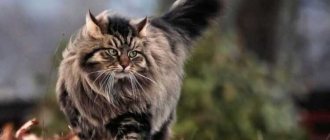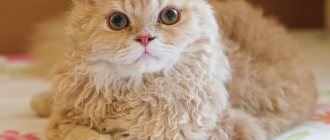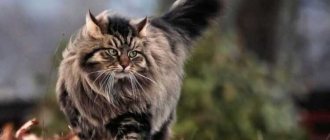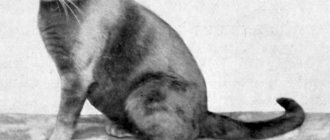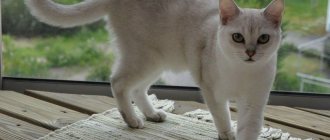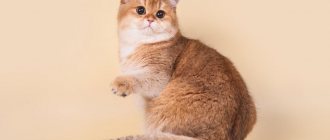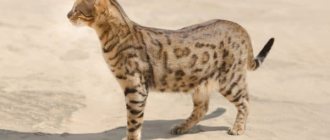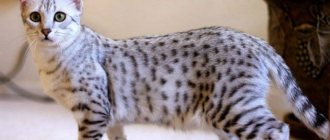The word “bicolor” may seem strange to some, but this is what professional felinologists actually call simple two-color cats. It must be said that this color is characteristic only of some breeds of domestic cats.
It received official recognition in the world of felinology relatively recently.
Most breeds were recognized in 1969. It was then that bicolor cats began to be specially bred and shown at exhibitions. Until this time, cats of this color were considered defective and excluded from breeding.
Currently, it is believed that bicolor cats are the most gentle, friendly, obedient, balanced and kind. They are very easy to bathe and comb. True, this needs to be done quite often - two-color cats need grooming at least once every ten days, and it is better to do brushing every day.
Some experts even suggest that it is the need for more frequent grooming than for cats of other colors that is the reason for its relatively low popularity.
All “real” cats are bicolor and have a dominant color: black, white, chocolate, gray, etc.
Statistics confirm that the demand for bicolor cats is significantly lower than for cats of other colors.
The quality of color in bicolors is determined by their dominant color, on which monochromatic spots of large or small size appear. The name of the color is based on the main, background color. For example, black and white color means white spots on a black background, and white and blue color means blue (gray) spots on a white background. The same applies to all other colors and their combinations.
The most important requirement for bicolor cats is that the spots should not mix with each other, and mainly the upper part of the body should be colored. It is worth mentioning that another name for bicolors is periodically found in the literature, which is most often applied to British cats - magpie (from the English “Magpie” - magpie).
Standard color requirements
A common requirement for all cats of this type (van, bicolor, tricolor, harlequin) is a clear separation of spots of different colors on the surface of the fur. That even a white hair should not penetrate the painted area. Based on these requirements, the pattern on wool looks like a colored mosaic of archaically arranged elements. The nose and pads on the cat's paws are colored according to the main color of the fur coat. The rich golden-orange color of the eyes indicates a high percentage of coloring pigment in the cornea.
The tuxedo
Tuxedo cat A cat in a tuxedo walks on the grass.
A tuxedo cat
, or
Felix the Cat
, [9] is a two-colored cat with a white and black coat.
They are called tuxedo cats because they appear to wear the type of black tie formal wear commonly known in the US and Canada as a tuxedo. The tuxedo pattern is not limited to black, but the name is usually reserved for black and white cats. Most tuxedo cats are black masked cats, a common name for felines whose complexion makes them look as if they are wearing a black mask over their eyes and often over their entire head. For a cat to be considered a true tuxedo cat, the cat's coloring must consist of a solid black coat with white fur limited to the paws, belly, chest, throat and often the chin, sometimes the tail, although many tuxedo cats appear athletic. goatees due to the black coloring of their lower jaw - that is, the lower jaw and chin. Bicolor can also be seen in skin color. The paw pads may be black or pink, often matching the fur in the area; if the color line crosses the underside of the paw, the pads on both sides may be different colors or even two colors.[ citation needed
] White faces or vertical stripes are a common attribute of tuxedo cats.[10] Tuxedo cats in the US are usually black.
Color genetics including white
Since the trait of this species is dominant, offspring with white color can only appear if the father or mother (preferably both) have white spots. If only one parent is the carrier, there is a high probability of giving birth to a mitted kitten (mit gene). At the birth of a baby, colored spots on the fur are already present and as they grow older they become brighter, and their boundaries become sharper.
In the genetic classification, the gene for white spots is S, the gene for the absence of these spots is s.
- SS (homozygous) is a characteristic of a carrier of dominant heredity. Such a parent produces exclusively kittens with snow-white spots;
- Ss (heterozygous) is a characteristic of a carrier of two types of heredity: plain and white. In a pair of two parents having this gene, there is a possibility of offspring with and without white spots;
- ss (homozygous) is a characteristic of a cat without the necessary heredity at all. A father and mother with such a set of genes never produce offspring with white spots.
Subspecies of colors with white spots:
- Bicolor (SS or Ss gene) – two thirds of the coat is colored, the rest is white;
- Harlequin (Sp gene) – the colored fur area is no more than one sixth (on the tail, hind legs and head);
- Van (gene Sv) – almost completely snow-white, only the tail is colored.
The gl gene is recessive and is responsible for the color of the limbs.
The Oa gene is dominant and can produce snow-white patches on the cat’s body, subject to the obligatory condition of the blue color of the cornea.
A scandal broke out at the exhibition. The cat owner dreamed of participating in the Best-in-Show and suddenly... a complete failure: the judge transferred his pet to class 13X. What does it mean? Expert Irina Kharchenko answers this and many other questions. — What explains the presence of characteristic, very special colors in cats of a number of breeds?
— Archaeological excavations and other types of scientific research have led to the emergence of several hypotheses about the origin of this or that cat breed. In accordance with this, the color of the animal is considered as an integral part of the exterior. For example, there is a version of the origin of Persian cats from Turkish Angoras; according to other sources, their ancestors lived in the mountains of ancient Armenia. Moreover, felinologists suspect the wild Pallas cat not only of the origin of the Persian breed, but also of transmitting its cream color.
Different continents, different wild animals stand at the origins of domestic animals. Hence the colors inherent in cat breeds. The history of the emergence of the spotted-colored Egyptian Mau and Ocicat, a new American breed obtained from crossing domestic cats with wild ones, can be traced quite clearly. The Ocicat is such a wildly graceful creature that it is difficult to imagine it at home.
— Some breeds have many colors, while others have only one. Can color be considered a breed characteristic in this case?
— It is impossible to definitely name color as a breed characteristic. It can be noted that in this breed there are animals of only one color, and even then with a reservation. Maybe five years ago there was one color, but today it seems to be the same color, but with variations. For example, Turkish vans. Previously, only red animals were described in the standard, the rest were disqualified. Today cream ones are already allowed. A similar situation, although controversial, is with the Russian Blue. By basic world standards, these cats exist in one color, but some felinological organizations in Europe recognize that there are Russian Blues in black and white versions. White Russian blue or black Russian blue sounds a little funny, but nevertheless it is so. If we consider the FIFe standard as a reference, then we can say that blue color is a breed trait. But there are very few such cat breeds.
— Which breeds, on the contrary, are characterized by a wide range of colors?
— The largest number of colors is found in cats of popular, ancient breeds: Persian, European shorthair, British. By the way, all colors are repeated in the Siamese version: blue is blue point, black is seal point, etc., but the marks are visible only on the ears, muzzle, limbs and tail.
According to the CFA system, today there are about 280-300 colors of Persian cats, but the richest range is found in Maine Coons, Norwegian Forest cats and Rex cats. If the Persians are considered in six groups; solid colors, particolors*, bicolors and tricolors, cameo and smoke, silver chinchilla group and color points, then Maine Coons, Norwegian Forest and Rex have the right to agouti - a color that, in combination with white, gives an insane number of options,
(* Particolor - a group of particolors includes varieties of tortoiseshell color)
As for ancient breeds, felinologists adhere to conservative positions and prefer pure colors. If, as a result of incorrect crossing (color point to bicolor, cream cameo to red marbled, chinchillas to silver marbled cats), a non-standard color is revealed, then the cat should be transferred to class 13X. This means that the cat has a so-called unrecognized color.
— Is there such a thing as the value of color, and what role does color purity play?
— For Persians, the type comes first, the quality of the coat comes second, and only then the color. Therefore, the cat with the best head type will be the first at the exhibition, but if her color has let down, then the overall score, of course, decreases. Competition is higher where the breed has only one color accepted as a standard, for example, Russian Blues, Korats or Turkish Angoras. What matters here is the tone, how silvery the coat is, etc.
— What colors of cats are considered to be the main ones?
If we speak in normal language and do not use special terminology, then the entire range is based on white, black, red, blue, cream and tortoiseshell colors. There are weakened colors. For black it is chocolate and blue. With the participation of both weakened genes - purple, etc. In addition, there are various color transformations in the form of tortoiseshell cats in different shades. The entire further range is built on the basic colors, which are intertwined in the most bizarre combinations. — I noticed that you often say ginger cat, and not red, as is customary among domestic breeders.
“All my life I’ve been calling them redheads, being narrowly in opposition to other clubs.” Our felinologists don’t like the word red - it’s too simple. We always want to complicate what is generally quite simple and obvious.
We can’t say: the color is tortoiseshell and white, but it must be tortoiseshell on a white lining. The term stop is translated as saddle. The shaded cameo has become a shaded cameo with or without a veil. For what? When there are already special English terms that are accepted in all countries, and they sound good. If you do translation, then sometimes from one short word several words grow, completely incomprehensible to a normal person.
— What is the difference between a Persian cat with a shell color and a cat with a shaded color?
— The difference between the shell and shaded colors is as follows: in the cameo shell the end of the spine is colored by 1/8, and in the cameo shell it is 1/3 shaded. Thus, shaded is slightly darker, and shell is the lightest of the cameo group.
In chinchillas (group 10), the end of the spine is also 1/8 colored and can be designated as black cameo. Another thing is that the breed transformed from a cameo with yellow eyes to a cameo with green eyes. Therefore, group 10 combines almost white cats with a barely visible dark veil.
— What recommendations can be given for crossing Persian cats to avoid obvious mistakes?
— There is a general rule that allows you to cross cats within each group: cameo, solid (solid color group), chinchillas, color-points, etc. Crossings between groups can also be carried out, but this must be approached with extreme caution so as not to achieve the opposite result and not deteriorate the breed. For example, a breeder breeds two cats: one with cameo color, the other black. For what? It turns out, oddly enough, if you constantly work in the cameo group, then the main feature disappears - the contrast between the light white-silver undercoat and the darker ends of the guard hairs is lost. To increase the contrast, at a certain stage a solid color is added, which, with its purity, will give a clearly distinguishable typing** in future generations. The solid color can be any color, but it is necessary to study the color pedigree if you want improvement in a particular trait. Most felinologists in this particular case use strong colors: black and red, less often blue.
(**Typing - white-silver undercoat combined with colored ends of the guard hairs)
— What genetic possibilities exist for improving color?
— There are plenty of options for improving color, and not least of all is crossing with animals of the main color. For example, a cream cameo cat, which does not have very clear typing, is bred with a cameo cat, with clear typing and good color reproduction (the usual method of improvement), or with a blue or black cat. Half of the offspring will be a solid color - they will take after the father, and half will be a cameo, like the mother.
- Some breeders, I know, cross animals of black and white solid colors in the hope of getting a two-color porridge - bicolor.
From such marriages bicolors are born, but only if the white partner is bicolor. Bicolors are born from bicolors. To obtain this color, you need to cross white animals for several generations to get a cat with a white spot. Then backcross to white until the white accumulates and you get a two-color animal.
There is a special term - white accumulation. The work on obtaining bicolor animals has been done a long time ago, and today to obtain a cat with this color it is enough for one of the parents to have it. Bicolor is rare, but can be obtained from parents with a solid color, but then they must have such animals in the underground***.
(*** Underground - meaning the gene pool of the ancestors)
— Why are some owners afraid of white color?
| Cat x Cat | Kitten coat color | ||
| Cats | Cats | ||
| 1-black | 1 - black | 1, 3 | 1, 3 |
| 3 - blue | 1, 3 | 1, 3 | |
| 4 - red | 4, 5 | 11, 13 | |
| 5 - cream | 4, 5 | 11, 13 | |
| 11 - tortoiseshell | 1, 3, 4 , 5 | 1, 3, 11, 13 | |
| 13 - blue-cream | 1, 3 , 4 , 5 | 1, 3, 11, 13 | |
| 3 - blue | 1 - black | 1, 3 | 1, 3 |
| 3 - blue | 3 | 3 | |
| 4 - red | 4, 5 | 11, 13 | |
| 5 - cream | 5 | 13 | |
| 11 - tortoiseshell | 1, 3, 4, 5 | 1, 3, 11, 13 | |
| 13 - blue-cream | 3, 5 | 3, 13 | |
| 4 - red | 1 - black | 1, 3 | 11, 13 |
| 3 - blue | 1, 3 | 11, 13 | |
| 4 - red | 4, 5 | 4, 5 | |
| 5 - cream | 4, 5 | 4, 5 | |
| 11 - tortoiseshell | 1, 3, 4 ,5 | 4, 5, 11, 13 | |
| 13 - blue-cream | 1, 3, 4, 5 | 4, 5 , 11, 13 | |
| 5 - cream | 1 - black | 1, 3 | 11, 13 |
| 3 - blue | 3 | 13 | |
| 4 - red | 4, 5 | 4, 5 | |
| 5 - cream | 5 | 5 | |
| 11 - tortoiseshell | 1, 3, 4 , 5 | 4, 5, 11, 13 | |
| 13 - blue-cream | 3, 5 | 5, 13 | |
— The white color is generally very complex, cunning and interesting. A white kitten is obtained if at least one of the parents is white. Moreover, if we breed a black cat with a white cat, then half of the litter will be white, and half will be colored. Statistically, of course. Moreover, the colored ones will be colored in accordance with the mother’s pedigree. The white cat seems to hide its colored appearance under a white mask. In fact, she is of one solid color - either black, or blue, or red... This can only be revealed by crossing her one by one with cats of certain colors. Let's say that by crossing her for the first time with a blue cat, the second time with a red one, the third time with a black one, we will establish what kind of soul she has, what color. If the mother is colored and the father is white, then all of the above remains in force, but applies to the cat.
— If you cross endlessly, what color will the cat end up with?
- White. This color is dominant. Although it is difficult to talk about dominance. It is known, let's say, that the solid colors black and red are the main ones, all the others are derivatives of them. Professional breeders gravitate towards type, while amateurs gravitate towards light colors: cream, blue, silver.
There were breeders who were ready to give half their lives for an animal of a rare color (chocolate or lilac), but at the last moment common sense prevails, since when the color is weakened, the type goes away. A beautiful and rare color will not replace a head that is far from perfect.
— Do you often see cats with unrecognized colors at shows?
— It all depends on the expert’s mood. A less benevolent judge, in order not to upset the owner, will give a good rating, remembering that this in any case does not allow participation in breeding and producing vicious offspring. In the worst case, disqualification occurs. And the best option is when the cat is transferred to the PERx class. This is how an unrecognized color is designated (previously it was designated 13X). Let's say you are the happy owner of a black Persian cat with a white medallion on the chest (this color is not in the standard), and I, as an expert, will transfer it to the PERx class or give it a good rating, or disqualify it. A cat in the PERx class is disadvantaged only at an exhibition, since it receives a rating without a place, but it can be recommended for breeding.
— How many colors are recognized as the standard today?
— The Persians have about 300, and there are still some that are not recognized. For example, agouti, whitened, when the cat has a white chest or in so-called socks, stockings. All these colors are a defect for a Persian cat, but for, say, a Cornish Rex they are normal.
Bicolor color is when at least one third of the body is painted white and, accordingly, two thirds are colored: black, red, cream, etc. Next comes "harlequin". In this color, the colored spots make up a maximum of one sixth and are placed in a certain way. They must be on the head, two or three spots on the back and front legs, colored hind legs and a colored tail are allowed. The next step, an almost white cat, is the Van. Vans came from harlequins as the latter accumulated white color. The name of the color, as you might guess, comes from the Turkish Van. Only in classic Turkish cats the colored cap on the head is divided by a white blaze, while in Persians this is rare, but they are forgiven. Two or three spots on the back are allowed (preferably their complete absence) and a colored tail. Thus, a cat with colored ears and a tail is called a van.
— Where do cats with unrecognized colors come from and how to avoid mistakes in breeding?
— There is no universal recipe. Our club has adopted a form of advisory breeding, and there are courses for felinologists. It is better for beginning lovers not to get into the wilds of felinology: breed solid-colored and color-point cats, chinchillas and cameos, and engage in inbreeding. It is better to breed cats in your own group: solid color on solid, cameo on camso, color point on color point. This is a win-win, sustainable option. Over time, when you gain experience, you can go further: try to improve the cat’s phenotype or individual aspects of the exterior, including color, using special breeding methods for pairing.
— What kind of crossbreeding of cats is completely unacceptable?
— This question cannot be answered unambiguously. In my opinion, any options are acceptable, but it must be justified somehow. Until recently, silver marbled animals were crossed with chinchillas, but this was due to the small number of cats from both groups. The result was a chinchilla with a defective pattern, which excluded the cat from both the ranks of chinchillas (tenth group) and silver merles (seventh group). Now that there are enough purebreds, such matings cannot be carried out, and it is simply stupid. In this case, I justify the Hungarians who started with this, although we ourselves have already been burned by animals whose ratings were reduced and the owners had to cry. Of course, you cannot breed chinchillas and color-point dogs, arguing that this is what the Poles did in 1985.
Mating smoky cats and bicolor cats is difficult. According to the classical European system, marriage is resolved in 90% of cases. FIFe does not recognize cameo bicolors, but the WCF standard, on the contrary, recognizes bicolors with a smoky base tone. Therefore, if your kitten is in the WCF system, everything is fine, but then you should not appear with it at FIFe or CFA shows.
— What happens from the connection between colorpoint and chinchilla?
“For example, the cat might turn out to be black up to the waist, and then smoky, or one eye will be blue and the other green.” It is also possible for the offspring to have a solid color if you cross, for example, with a black bicolor, but in this case there may be a color point with white fingers or a medallion, or, again, difference of eyes (which in both cases is a disqualifying defect in color points).
But more often the defect manifests itself in color. It should be borne in mind that the chinchilla is essentially a black cat (although it looks quite snow-white)
— Chinchillas have remained one of the most popular varieties of Persian cats for many years. How many colors in this subgroup are allowed by the standard today?
— Like cats of solid color, chinchillas have ten subcolors: black, blue, lilac, chocolate. A red or cream chinchilla is called a cameo. Next comes tortoiseshell, blue-cream and so on. Most colors are theoretical. For example, I have never seen a purple turtle among chinchillas and I can only guess what it looks like.
— What mistakes do breeders most often make during breeding?
— The simplest thing is to select animals of the same, but not related color. This is already difficult enough. It is better not to cross a cream cat with a ginger cat. Most likely, it would be a mistake to marry a cream cameo cat with a red merle cat. The weakened red gene plays a role here. His variations on the theme of walking, shaded, plus combinations of patterns give amazing results. The fact is that mating cream and red animals is fraught with the fact that cream kittens turn out dark and it is difficult to determine whether they are dark cream or light red. By the way, red kittens from such matings suffer from weak color intensity. A cream kitten may have a red coat, and this is a lack of purity of color. All this does not mean that such animals cannot be bred at all. It is possible if a specific goal is being pursued: some kind of special inbreeding, obtaining the type of an unusual sire, reducing the size of the ears, body, etc. I would not recommend such experiments to amateurs.
— Usually, owners of purebred animals have problems choosing a cat. What color can be considered the most harmless in this case?
— White color comes first in terms of versatility. If you have a Himalayan cat, you can breed it with a white cat if there is no suitable partner from the subgroup. If the cat is bicolor, the same thing. White color will not allow PERx to go into the unrecognized, unidentified area. Thus, a white animal is the most harmless option. Although certain difficulties may arise, with the same difference of eyes, typing disorders in chinchillas, but nevertheless...
The second most universal color is black and black and white. So to speak, according to the degree of harmlessness. Black and white, again with reservations. You can breed with cats of a solid color, with a pattern without sophistication and recessive traits - typing, ticking and, especially, colorpointing (acronelism)!
Chinchillas are a completely separate group. What matters here is the purity of the color and the green color of the eyes - in general, there is enough trouble. Poor breeders are caught between three lights: color, eye color, type. Stupid group: if you achieve the color of your eyes, your nose will come out, if you remove your nose, a yellow rim will appear on the iris of your eye, etc.
— What options are available in practice? For example, when crossing a tortoiseshell cat with a white cat, can you get a tricolor? Do any funny things happen?
- Actually, there are funny cases. Moscow breeder Oleg Smolenchuk has a magnificent black-smoky cat, who was born from a white cat and a cream mother. What do well-wishers and “experts” say? The cat has a fake pedigree. If a thinking person, he will look at the pedigree of the cat’s parents and it will become clear how such a split occurred. In this case, the kitten's grandfather was black and smoky in color.
— How do professional breeders organize their work?
— Most specialize in one color range: only solid colors or only smokey, but there are also universal nurseries. A blue cat and a calico cat can potentially produce kittens of eight colors. There will be bicolors and solids, possible harlequins, etc. In this case, the nursery advertises the diversity of offspring. The greatest variety is provided by tortoiseshells and blue-cream animals, as can be seen from the compatibility table.
— In what case is it considered that a cat has a good color?
- Everyone has shortcomings. The white color usually causes colored spots on the head, between the ears, but at the age of 8-9 months they go away during the first molt. Inexperienced breeders sometimes even drown kittens in panic.
The blue color suffers from residual marble, although it is rarely noticeable. But if you wish, you can always see dark gray stripes on a light background, rings on the limbs and tail. A classic animal should be without overcoloring - differences between the dorsal stripe and the color of the fur on the belly, as well as between the shade of the guard and the undercoat.
The redhead also suffers from residual marble, the letter M on the head, and streaks on the sides. Therefore, when breeding, it is necessary to avoid animals that have marbled ancestors in their family. Or, on the contrary, enhancing the marble pattern, they look for cats with the corresponding pedigree.
In addition, a characteristic disadvantage of cream-colored animals is their dark color, while for red animals, on the contrary, they have low intensity.
Tortoiseshell cats, due to the presence of both colors, can have all of the above disadvantages. True, this is not as noticeable as in animals of solid color.
For particolors, the main thing (since there are two colors) is the placement of spots, the beauty of their arrangement. Spots of various colors should be on all parts of the body. It often happens that cats have a lot of blue, or a little cream, or the cat is blackened. In our country, darkened “turtles” are more common. At one time, there was an opinion among breeders that it was preferable to have a tortoiseshell cat with a predominance of red color. But this is also bad. Ideal - 50 to 50. Although visually I like red turtles more. They are more effective.
It’s hard to talk about chocolate and purple ones. These cats are for lovers of exotics, but for a professional it is better to have a cool white cat, of which there are millions, than the only one, but weak in appearance, a lilac one.
V. Rumyantsev talked with Irina Kharchenko
Classification by main types
White spotted Britons are classified by type using the following coding.
Bicolor is coded as 03, harlequin - 02, van - 01. There is also a code 04 for the "mitted" color, but such animals are discarded due to too little white content.
Let's take a closer look at the three main breed standards, and then at the representatives of mixed colors.
Almost completely snow-white cats with a colored tail. Additionally, there may be a couple of spots on the head, but the ears should be snow-white, without colored splashes. A small number of stains along the back are allowed. Colored spots must be evenly colored, without white hairs and always with sharply defined edges.
From a genetic point of view, Van cats with an overwhelming predominance of white in coat color are homozygous with a dominant gene (SS). It is extremely rare that, as an exception, a heterozygous (Ss) Van kitten may appear in the litter.
Harlequin
In harlequins, the colored part of the body, like in the Vanir, begins with the tail. But there is more color. It is present on the head and part of the back. The ears are colored (or at least one of them). The forelegs may remain white, but a few spots of color are acceptable. The collar area is snow-white. In total, the total area painted with the primary color should not exceed one sixth of the body surface.
Bicolor
Bicolor Britons have white hair covering less than half of their body, but more than one third of their body. That is, approximately from 30% to 50%. On the forehead of a bicolor, a distinctive feature is a small snow-white equilateral triangle with the apex on the forehead and the base on the chin. A slight shift to the right or left is acceptable.
The collar, belly and chest of the cat, as well as the paws on the inside, remain white.
The main solid color (gray, black, chocolate, etc.) of the British biocolor is painted on the back, ears and tail. A mandatory condition for all Britons of this color: the colored and white spots must have clear boundaries, not mixing with each other. The presence of uncolored hairs among an array of colored fur is also considered a deviation from the standard and leads to the culling of the individual. There is also an aesthetic requirement - the painting should look complete and make a harmonious impression.
Bicolor breeds
The most popular and widespread two-color cat breed is, of course, the British cat. Two-colored kittens are very common in litters of British cats. In addition, they have a wide variety of colors - from classic black and white to creamy white or exotic lilac-white.
This variety of British cats was recognized only in the early 70s, and in the United States they were recognized a decade later.
Harlequin cats were isolated from the general population of British bicolor cats in 1986.
Harlequins are the same bicolors whose dominant color (usually white) occupies about 5/6 of the entire body, and only 1/6 has spots of a different color. However, in most cases, a two-colored individual of this type can wear at most three spots on any part of the body except the belly. Among other things, this type of British cat is distinguished by its dark orange or copper-colored eyes. True, sometimes you can find an exotic variety of British bicolor, when one eye is orange and the other is blue.
Another breed of cat, among which bicolors are often found, is the Van. These cats are characterized by a completely white color and only a few white spots located on the head. It is worth mentioning that spots can affect both ears.
Now bicolors are a “fashionable” and quite numerous color in many breeds.
In addition to these two breeds, two-colored individuals are quite common in the super popular Persian cats. Such bicolors have two subclasses, which are divided among themselves depending on which color is dominant - it can be either white or some other color. In addition, bicolors also include those Persian kittens whose coat is colored in the dominant color by at least 50%.
In addition to the above-mentioned breeds, Angora bicolors and Siberian two-color cats are very popular among breeders. The former are represented by several color options and have an amber-orange iris, while for the latter any amount of white and white spots are acceptable, which can be combined with any dominant color.
Solid (solid, plain)
A solid color implies the absence of any slightest admixture of other shades. The surface of the fur is colored evenly on all parts of the body. The Scots once upon a time considered gray or blue to be the most common color. These are the favorites most often found among breeders. But today seals with other colors are also gaining more and more popularity: white, chocolate, black, brown, cream, red and fawn (which literally means the color of a young deer). Sometimes it happens that nature interferes with the uniform color of the fur and leaves a mark of a different color there. Such cats noticeably lose value because they are considered a breed defect.
Point (point)
The more common name for this color is color point. It is characterized by the fact that the main color of the animal turns into a darker color at the tip of the muzzle, tail, ears and paws. This is due to the fact that in the blood of such animals there is a special gene that affects the darkening of the hair in those parts of the body where the temperature is low.
There are several variations of this color, which are shown in the table below, there may be others:
| Color name, photo | Main color | Additional color |
| Seal Point | Light beige | Brown |
| Lilac Point | Pale blue | Dark blue |
| Chalklit Point | White | Brown |
| Cream-point Cream-blue-point | Pale cream | Cream |
| Red point | Pale cream | Ginger |
| Tabby (lynx) point | Any | Stripes to match the main color |
| Torty point | Tortoiseshell | Red or cream spots on the base coat color |
Torti (turtle)
It should be noted right away that you can only buy a turtle girl. In males, this color is not provided by genetics. But if you do come across a cat like this, then this is a big exception, which, however, does not increase its cost, but, on the contrary, reduces it.
Tortoiseshell color is considered to be fur on which spots of different colors (black, chocolate, blue, lilac) alternate with red or cream marks. For breeders, a particularly important indicator is the intensity of pigment expression and uniformity of location.
Smoky (smoky, smoky)
The main condition for this color is that the hairs at the base of the body must have a silver-white tint. Those. the silvery-white hair turns into another color, such as black or blue. This phenomenon is called typing and occurs as a result of a dominant silver gene. The smoke can be different, for example, chocolate.
There are often cats with additional patterns on their fur, but according to color rules this should not be the case.
Don't confuse this color with a solid color! If you're not sure, part your cat's fur and see what color is at the base of his fur.
Breeding bicolor cats
Breeding two-color cats is a very complex matter that requires the breeder to have a lot of experience, no less knowledge and solid skill.
Even breeders with ideal colors may produce kittens of other colors. Just trying to ensure that all the kittens are two-colored will require a lot of effort, and in order for the entire litter to be of equal value, it will require skill on the verge of virtuosity. At the same time, all breeders working in this direction unanimously claim that this is an extremely exciting activity. They are especially fascinated by their attempt to achieve a symmetrical pattern in bicolor kittens, which is incredibly difficult to implement in practice. It is for this reason that kittens and cats with this pattern are very rare and very expensive.
In most cases, the typical bicolor cat is born from the mating of a bicolor cat and a calico tortoiseshell cat. The second common option is when both parents are two-colored. Different combinations of sire colors can produce up to seventeen different color variations in kittens. Perhaps it is for this reason that breeding kittens of this color is becoming increasingly popular among breeders around the world, becoming more and more interesting from their point of view.
If you find an error, please select a piece of text and press Ctrl+Enter.
Tabby (tabby)
Such cats have stripes of an unusual shape and a different color than the main color. The most common marks are on the forehead, for example, in the shape of the letter M, light spots on the back of the ears, a necklace on the chest, rings on the paws and tail, curls on the cheeks, eyes outlined as if with shadows.
Breeders distinguish several variants of tabby. According to the type of pattern, they are marbled (shaded), tiger (mackerel) and spotted (spotted).
There is a complex classification of Scots tabby dogs based on combined colors and shades. They are presented in the table below:
| Name | Main color | Pattern color |
| Silver | Silver | Black |
| Silver blue | Light blue, white undercoat | Mantle on muzzle, tail and sides |
| Red | Light red | Bright red |
| Brown | Cream blue | Bright blue |
| Cream | Pale cream | Beige or dark cream |
| Cameo |
Shedded (shaded)
With this type of color, two-thirds of the hair starting from the base is white, and the remaining part can be red, silver or gold. On the chin, belly and lower surface of the tail the color is light. The shaded color does not allow spots or stripes except those located on the forehead or paws.
Representatives of the Scottish breed with a similar color have white coat color as the main color, and the tail and muzzle are decorated with a different color or a combination of both (torti). There may also be spots on the body and paws.
In popular culture
See also: Fictional cats
In the United Kingdom, the tuxedo cat came to be depicted as the "Jellicle cat" in the fictional tribe of nocturnal black and white cats described by T. S. Eliot in Possum's Book of Old Cats
, which was first published in 1939.[11]
In its derivative musical, Cats
, the tuxedo cat personifies the magical Mr. Mistoffelees, who is portrayed as a stage magician wearing a lace ruff and bow tie, as well as the character Bustopher Jones whose outfit consists of a tuxedo and a brawl.
The musical differed from the book in that the characters included cats with different coat colors rather than just two-colored cats, but it retains the repeated statement that "Jellicle cats are black and white." Cats with these markings also played a major role in the drawings illustrating Real Cat
, a book written by Terry Pratchett with cartoons by Gray Jolliffe.[12]
Other famous cartoon bicolor cats include: Sylvester the Cat, Felix the Cat, Tom and Jerry
, Oggy from Oggy and the Cockroaches , Puss from Puss Who Hates People and the Cat Ventriloquist , Krazy Kat , [13] Jess from
Postman Pat
, Kitty Softpaw from
Shrek
Extra Benefit
Puss in Boots
, Figaro the Beans and Sebastian the Cat from
Josie and the Pussycats
.
A bicolor cat named Mittens is one of the main characters in the 2008 Disney animated film. Bolt
.
Aldwyn is from Familiars
Tuxedo Cat, and Meowris (voiced by Paul Frees) is from
Gay Purr
Bicolor.
The Tuxedo Cat is also the main character of a popular children's book. Tip-Top Cat
, and another one is one of the three cat breeds in the video game.
Mine craft
.
Morgana, playable character in JRPG. Persona 5
is a two-color cat.
Bo, a character from the Abby Hatcher
, is Fluffy, who resembles a tuxedo cat.
The rarest colors of Scottish cats
Several years ago, the highest price was set for kittens of unusual silver and gold shades. But in the modern cat market there are more and more of them. Today, ticked Scots and golden chinchillas are considered the most expensive.
Scottish straight golden chinchilla
Interesting! The most common iris color among Scots is gold. However, there are some exceptions. Usually the eye color matches the coat. Blue or multi-colored eyes are quite rare, these animals can be white, bicolor or tortie. Orange iris is a very beautiful, but the rarest eye color in this breed.
Genetics of Scottish cat colors
In cats of this breed, 2 genes predominate, which are responsible for the red and black color. One of them acts as dominant, and the other as recessive (i.e., the one that is suppressed). There is also a 3 diluent gene, which is responsible for the saturation of the pigment. These genes are combined and as a result we get a variety of colors: from the well-known blue to the cheerful-looking harlequin.
By the way, while the kitten is still small (several weeks), it is impossible to say exactly what its color will be. The final coloring is formed when, after a child's molt, the coat is replaced by an adult coat. Usually the color is ready by six months, although it may change slightly for another 1.5 years.
Genetics of coat patterns
Main article: Genetics of cat fur
Image of unique facial markings Cat wearing mask and robe
The primary colors and patterns of a cat's fur are determined by fewer than ten genes.[4] Cats with white fur are considered mutants. White spots
a gene that prevents the coat color from forming patches on a cat's body. This gene has been studied in several species, particularly mice, and is codominant to normal coat color because it prevents melanocytes from migrating into developing hair follicles.[5] The genetics of this pattern are not as well understood in cats, but at least some of the genes involved in melanocyte migration and survival may play a role similar to that of other animals.[6]
There are three possible genotypes with S
(white spots) gene, with a capital
S
standing for a wild-type copy and a lowercase
s
standing for a mutant.[4]
- SS (two dominant alleles) result in a high degree of white spotting (sometimes resulting in a solid white cat or a white cat with several colored hairs)
- Ss (one dominant, one recessive allele) produces moderate white spots.
- ss (two recessive alleles) results in a solid color or low degree of white patches (sometimes just a few white hairs)
The absence of tabby stripes in bicolor cats is controlled by a protein called agouti, which suppresses the production of melanin and thereby prevents the formation of dark hair color.[7] In agouti cats, the gene turns on and off as the coat grows, resulting in hairs with alternating yellow and black stripes.[4] In domestic cats, inactivation of the agouti gene, a deletion mutation, causes an entirely black coat color.[8]
Scottish cat color charts
When purchasing a Scottish kitten with a passport from a breeder, most likely you will see markings of numbers and letters there. This is an international code used in the classification accepted among breeders. The Scottish breed includes four cats: fold-eared (Scottish Fold), straight-eared (Scottish Straight), long-haired fold-eared (Highland Fold), straight-eared long-haired (Highland Straight).
This is what the color code looks like: XXX.xx.NN.NN.NN.(NN) , where:
XXX . Abbreviated name of the breed in three capital letters: SFS - Scottish Fold, SFS 71* - Scottish Straight, SFL - Highland Fold, SFL 71* - Highland Straight.
xx . Lowercase letters indicating the main coat color (up to two):
Russian nameabluebluebchocolate, brown, chestnutchocolate, brown, Havana, champagneclilac, lavenderlilac, lavender, platinumdred, flameredecreamcreamfluortoiseshell, patch tortoiseshellgblue-cream, blue-tortieblue cream, blue tortoisehchocolate-tortiechocolate tortoisejlilac-tortielilac turtle ovynblack, ebony, seal, sable, ruddyblack, ebony, seals, sable, wildosorrel, cinnamon, honeysorrel, cinnamon, honeypbeige fawnyellow-brown, beigeqsorrel tortiered-brown tortoiseshellrbeige fawn tortiebeige tortoiseshellsilver, smokesilver, smokywwhitewhiteygoldengoldenzunregisteredunregisteredNN.NN.NN.(NN) - values of pairs of digits (up to 3 main and 1 auxiliary):
- Numbers from 1 to 35, which decipher the color features (harlequin, van, smoke, etc.):
| Letter (designation) | English name | Russian name |
| 01 | van | van |
| 02 | harlequin | harlequin |
| 03 | bicolour | two-color, bicolor |
| 04 | mitted/white point | with white markings (for color points) |
| 09 | little white spots | white spotting (1-2 cm) |
| 11 | shaded | shaded (1/4 of the top part of the hair is darkened) |
| 12 | tipped, shell | veiled (1/8 of the top part of the hair is darkened) |
| 21 | tabby, agouti | striping, agouti factor |
| 22 | blotched, marble | marble |
| 23 | mackerel, tiger | mackerel, tiger |
| 24 | spotted | spotted |
| 25 | ticked | ticked or Abyssinian |
| 31 | burmese | Burmese |
| 32 | tonkinese | Tonkinese |
| 33 | himalayan or siam | Himalayan, Siamese, point |
| 34 | Singapore | Singaporean |
| 35 | abyssinian | Abyssinian |
- A pair of numbers from 51 to 54 indicating the length of the tail:
| Letter (designation) | English name | Russian name |
| 51 | rumpy | taillessness |
| 52 | rumpy riser | remainder of the tail – 1-2 vertebrae |
| 53 | stumpy | bob – 7-13 cm. curled tail |
| 54 | longy | long/normal tail |
- A pair of numbers from 61 to 67 indicating eye color:
| Letter (designation) | English name | Russian name |
| 61 | blue | blue |
| 62 | yellow, golden | yellow, orange, golden |
| 63 | oddeyed | disagreement |
| 64 | green | green |
| 65 | burmese | Burmese cat eye color |
| 66 | onkinese | Tonkinese cat eye color |
| 67 | himalayan or siam | eye color of Himalayan and Siamese cats |
- A pair of numbers 71 (straight) or 73 (dropping), indicating the shape of the ears.
How coat color affects the character of a Scotsman
When purchasing a pet, you should not chase fashion; it is better to trust your preferences and tastes. The main thing is that the cat turns out to be “yours” in temperament and character. By the way, some cat owners are sure that the color of the fur affects the behavior of the animal and leaves an imprint on its character.
White and light colored
You want to cuddle these babies endlessly. But they, as a rule, do not like increased attention to themselves. Although they are very loyal to the owner, they are extremely wary and wary of other people. Among some peoples there is a belief that a white cat brings good luck. Whether this is true or not is not known for certain. But the white color can cause a lot of problems for the cats themselves, since 5% of all snow-white cats are born completely deaf. Previously, it was believed that deafness was the fate of absolutely all white-furred tails, but later scientists proved that this is not so. But when buying such a kitten, you should still be more careful.
Black
Despite all the existing prejudices and myths regarding black cats, in practice they are one of the friendliest towards people. They like to stay close to their owner all their free time and always keep him in sight. Charcoal cats are wise, quick-witted, and keenly aware of a person’s mood.
Redheads
Such animals are a ray of sunshine in your home. It is believed that a ginger cat in the home is the key to an indispensable increase in well-being. Those with fiery fur are very playful, willful, cheerful and curious creatures. The golden shades of fur that are fashionable today are characteristic of more formidable animals, whose disposition can hardly be called friendly. And golden Siamese cats are generally considered the worst tailed cats.
Blue and silver
Silver and blue fluffies are real aristocrats. Calm, balanced, noble. They love their owner devotedly, although they are not always ready to demonstrate this publicly. It is believed that these four-legged pets are able to calm and relieve stress in humans. In addition, cats of this color are absolutely not vindictive.
Two-color
Such cats are most in demand among buyers. In addition to their interesting color, they have an easy-going disposition, are friendly, and kind even towards children. Bicolor cats love their owners very much and get along well with other pets.
References
- ^ a b
“7+ variants of two-color patterns in cats (and why they occur).”
PetHelpful
. Retrieved March 29, 2022. - "Seychelles" List of recommendations from amateur breeders. Retrieved August 5, 2007.
- CFA Breeds. Association of cat lovers. Archived from the original on June 29, 2007. Retrieved 2007-08-05.
- ^ a b c
“Coat colors and types of fur.” Cat Genome Project. Archived from the original on June 30, 2007. Retrieved August 5, 2007. - Yoshida H, Kunisada T, Grimm T, Nishimura EK, Nishioka E, Nishikawa SI. (2001). "Review: Melanocyte Migration and Survival Controlled by SCF/c-kit Expression". J. Investig.
Dermatol. Symp. Proc .
6
(1): 1–5. Doi:10.1046/j.0022-202x.2001.00006.x. PMID 11764276. - Cooper M. P., Fretwell N., Bailey S. J., Lyon, L. A. (2006). "White spots on the maps of the domestic cat (Felis catus) near KIT on feline chromosome B1." Anim.
Genet .
37
(2): 163–5. Doi:10.1111/j.1365-2052.2005.01389.x. PMC 1464422. PMID 16573531. - Jackson AJ (1997). "Homologous pigmentation mutations in humans, mice, and other model organisms". Hm.
Mol. Genet .
6
(10): 1613–24. Doi:10.1093/hmg/6.10.1613. PMID 9300652. - Eizirik E, Yuhki N, Johnson WE, Menotti-Raymond M, Hannah SS, O'Brien SJ (2003). "Molecular genetics and the evolution of melanism in the felids". Curr.
Biol .
13
(5): 448–53. Doi:10.1016/S0960-9822(03)00128-3. PMID 12620197. - "Here's what to expect from tuxedo cats." Spruce pets
. Retrieved March 29, 2022. - Sufi, Franny (21 May 2015). "About cats in tuxedos." About.com
. Group About the company. Retrieved June 21, 2016. - T. S. Eliot (1982). Possum's Old Cat Book
. Harcourt. ISBN 978-0-15-168656-8. - Pratchett, Terry; Jolliffe, Gray (26 September 2002). Real cat
(New ed.). Orion. ISBN 978-0-7528-5369-7. - The Purrington Post
, February 1, 2022 - A tribute to tuxedos and their "tuxedos", the famous tuxedo

